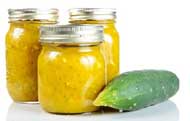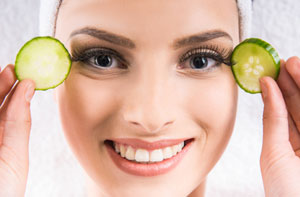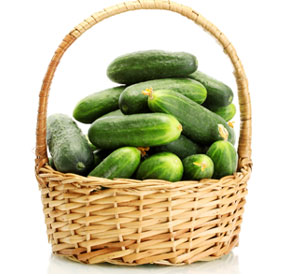





1. Cucumber Facts
2. Types of Cucumber (Australia)
3. Cucumber Nutritional Value
4. Cucumber Health Benefits
The cucumber (Cucumis sativus) is a member of the Cucurbita, or gourd, family.
Cucumbers are also known as gherkins. The word gherkin comes from the Persian word for cucumber: “angarah.” The word "gherkin" in English often refers to cucumbers in their pickled form.
Research indicates that cucumber cultivation appeared in France in the 9th century, England in the 14th century, and in North America by the mid-16th century.
Cucumbers are generally eaten raw in salads or pickled. There are many lesser known recipes with cooked cucumbers. Sweet or dill pickles, relishes, sauces, and dressings are made from cucumbers.
Cucumbers are mentioned in the Bible twice - Numbers 11:5 and Isaiah 1:8.
History and Origin
Cucumbers are believed to be a native of India and have been cultivated in western Asia for about 4,000 years. The cucumber spread to the Mediterranean and was especially loved by the Romans, who are believed to have eventually introduced the vegetable to Europe. Cucumbers were spread to the New World by the Spanish.
The Romans not only cultivated the cucumber, but also grew them in greenhouses so that Emperor Tiberius could enjoy them out of season. It is said that he ate cucumbers every day of the year and along with Julius Caesar was also a huge fan of pickles. Cleopatra is said to have credited pickles for at least some of her beauty.
While cucumbers have been cultivated for thousands of years, they were not improved and hybridized until the late 1800s. Varieties that are well-known today stem from these hybrids.
Vegetables " Cucumber "
Nutritional value per 100 g
Cucumber, with peel, raw
|
Nutrient ( Proximate's )
|
Unit
|
Value
|
Daily Value %
|
|
Energy
|
kcal
|
15 | 0.7% |
|
Protein
|
g
|
0.65 | 1.3% |
|
Total lipid (fat)
|
g
|
0.11 | 0.1% |
|
Carbohydrate, by difference
|
g
|
3.63 | 1.3% |
|
Fiber, total dietary
|
g
|
0.5 | 1.7% |
|
Sugars, total
|
g
|
1.67
|
|
|
Minerals
|
|||
|
Calcium, Ca
|
mg
|
16 | 1.2% |
|
Iron, Fe
|
mg
|
0.28 | 1.5% |
|
Magnesium, Mg
|
mg
|
13 | 3% |
|
Phosphorus, P
|
mg
|
24 | 1.9% |
|
Potassium, K
|
mg
|
147 | 3.1% |
|
Sodium, Na
|
mg
|
2 | 00.8% |
|
Zinc, Zn
|
mg
|
0.20 | 1.8% |
|
Copper, Cu
|
mg
|
0.041 | 4.5% |
|
Manganese, Mn
|
mg
|
0.079 | 3.4% |
|
Selenium, Se
|
mcg
|
0.3 | 0.5% |
|
Vitamins
|
|||
|
Vitamin C, total ascorbic acid
|
mg
|
2.8 | 3.1% |
|
Thiamin (B-1)
|
mg
|
0.027 | 2.2% |
|
Riboflavin (B-2)
|
mg
|
0.033 | 2.5% |
|
Niacin (B-3)
|
mg
|
0.098 | 0.6% |
|
Pantothenic acid (B-5)
|
mg
|
0.259 | 5.1% |
|
Vitamin B-6
|
mg
|
0.040 | 2.3% |
|
Folate, total (B-9)
|
mcg
|
7 | 1.7% |
|
Vitamin B-12
|
mcg
|
0.00
|
|
|
Vitamin A, RAE
|
mcg
|
5 | 0.5% |
|
Vitamin E (alpha-tocopherol)
|
mg
|
0.03 | 0.2% |
|
Vitamin D
|
mcg
|
0
|
|
|
Vitamin K (phylloquinone)
|
mcg
|
16.4 | 13.6 |
|
Lipids
|
|||
|
Saturated Fatty Acids
|
g
|
0.037
|
0.1% |
|
Monounsaturated Fatty Acids
|
g
|
0.005
|
|
|
Polyunsaturated Fatty Acids
|
g
|
0.032
|
|
|
Trans Fatty Acids
|
g
|
0.000
|
|
|
Carotenoids
|
|||
|
Beta-Carotene
|
mcg
|
45
|
|
|
Alpha-Carotene
|
mcg
|
11
|
|
|
Beta-Cryptoxanthin
|
mcg
|
26
|
|
|
Lutein + zeaxanthin
|
mcg
|
23
|
|

|
Reference Values are based on a 2,000 Calorie Intake, for Adults and Children 4 or More Years of Age. Your daily values may be higher or lower depending on your calorie needs.
|
|
Percentages are roughly approximated using (RDA) Recommended Dietary Allowances for adults. Source: USDA United States Department of Agriculture
|
|
Reference Values for Nutrition - FDA U.S. Food and Drug Administration
|
Cucumber Nutritional Value
Most of the nutrients in cucumbers are in the skin.
Cucumbers are often publicised as a healthy food because they are low in calories and have no fat. They also have many nutrients that make them a healthy choice for cooking and snacking. Cucumbers can be used to make lotions, treat medical problems, and aid in meditation. Most of the nutrients in cucumbers are in the skin. They are a good source of vitamin C, vitamin A, and folic acid. The skin also contains the minerals molybdenum, potassium, magnesium, manganese, and silica. The mineral silica promotes strength in the connective tissues and joints.
The skin of the cucumber contains a high amount of fiber and along with the high water content in cucumbers this can aid digestion. Fresh cucumbers, eaten daily, have been used as a treatment for chronic constipation. Foods high in potassium, magnesium, and fiber, like cucumbers, have also been used to help lower blood pressure.
Cucumbers are often used in facial masks to firm and tighten the skin. The ascorbic acid and caffeic acid in cucumbers reduce water retention and can help reduce swelling as well as puffiness around eyes. Slices of cucumber can be placed directly over the eyes or other swollen area or blended and used as a mask.
It is believed that cucumbers can reduce the pain and swelling of sunburn or windburn by placing slices on the skin or making a lotion. To make a cucumber lotion, juice a cucumber and mix the juice with equal parts glycerine and rose water. The phrase “cool as a cucumber” is reputed to be due to the fact of the high water content and minerals in cucumbers to have a cooling effect on the blood.
- LOWERS BLOOD PRESSURE (Potassium)
- CONSTIPATION (Source of dietary fibre)
- ALZHIEMERS DISEASE (Vitamin K)
- FIRMING OF THE SKIN (Ascorbic acid and caffeic acid)
- CONNECTIVE TISSUES/JOINTS (Mineral silica content)

- PROMOTES BONE HEALTH (Vitamin K)
- WEIGHT GAIN (Diuretic properties)
- AGING PROCESS (Antioxidants - Vitamin C)
- DIGESTION (High water content)
- COOLING EFFECT ON BLOOD (High water content & minerals)
References
|
Nutrient Database - USDA (United States Department of Agriculture)
|
|
Reference Values for Nutrition - FDA U.S. Food and Drug Administration
|
For More Information
Cucumber - From Wikipedia, the free encyclopedia
